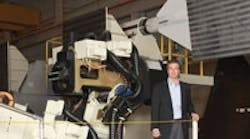Composite materials are already reshaping aerospace and big changes are being anticipated for automotive and wind turbines sectors. Is manufacturing entering the Age of Composites? The evidence is enveloping more and more of the global economy.
"With the use of composites, the major commercial aircraft providers -- Boeing and Airbus and even Lockheed -- are transforming commercial aircraft," observes Randy Kappesser, vice president and general manager of MAG Cincinnati's Composite Technologies operation.
"Boeing is with the 787 Dreamliner while Airbus is following with a scheduled delivery of the A350-XWB in 2012."
Both use record levels of composites. "Boeing's Dreamliner is 50% composites by weight and 80% by volume and is the industry's first passenger liner with composites used in the fuselage, airframe and wings. The Airbus A350 achieves a 52% weight reduction," says Kappesser.
By one estimate the annual fuel cost savings of a 787 operating as a passenger liner could reach $5 million. In addition composites offer operating advantages that are totally unrelated to its weight reduction potential. Examples are fatigue strength and corrosion resistance -- factors which have been estimated to save as much as $40 million over the life of the airplane. The comparison is with metals conventionally used in aircraft.
Kappesser describes part making with composites as a watershed event in manufacturing. "Unlike fabricating parts from metal with machine tools, fabrication with composites is an additive process where you essentially start with a tool and no material and subsequently build up the shape you desire."
That contrasts with traditional metal cutting where you start with more material than you need and trim away the excess to produce the required part configuration. Carbon fiber impregnated with a thermoset resin is presented to the processing equipment either in roles or in spools, depending on the machine and the width of the material. The machine then dispenses that material onto a tool as directed by a CNC program as per the designer's input. The machine performs the additive process. The machines can be very large since the part design determines the travel requirements and the size of the machines. Kappesser says MAG Cincinnati has machines that can produce five- and six-meter diameter cylinders to the design length required.
"Advantages with composites only begin with the strength to weight ratio. In addition, the parts can be unitized, meaning that the composite fabrication process integrates many parts into one. That's how a designer of a composite airplane can replace a metal fuselage of some 3,000 parts with a composite two-part assembly, a forward fuselage and an aft fuselage," explains Kappesser.
Does the advent of the Age of Composites imply that conventional machining will no longer have a role in manufacturing with composites? Kappesser says the need will continue, but the focus will be different.
"While product fabrication with composites is described as an additive process, some machining, primarily final trimming and final shaping of the composite, will still be necessary," he adds. But the type of product being manufactured also has some bearing on that machining question. For example, Kappesser notes that plants producing composite airplanes tend to be more dependent on titanium parts (and the machining of titanium parts).
In addition to the cost benefits of unitizing, the advantages of a composite design also include higher productivity and less material waste. Considered collectively, dramatic claims can be made for composite construction of products. One claim overheard at the recent International Manufacturing Technology Show (IMTS) in Chicago: "Make the plane out of composites and the savings will pay for it."
Regardless of how the benefits are expressed, Kappesser says "just to meet bookings for the 787 and A350-XWB, aerospace composite capacity will need to increase by several orders of magnitude over the next five to ten years."
But even more exciting potential can come from MAG Cincinnati's initiatives into automotive and wind power generation markets. Those markets will now have access to new materials and processes that have been tried and tested by the stringent performance requirements of aerospace. Kappesser expects the automotive market to be even more excited over vehicle fuel efficiency and performance.
MAG Cincinnati's new Composite Automotive Business Unit, directed by Daniel Allman, will focus on supplying process expertise and automated equipment solutions to composite applications and manufacturing systems ranging from Class A body panels to structural components. As in the 787, Kappesser expects automotive use of composites to proceed from components to entire vehicle designs, including structural components. He explains that the ability to tailor composite strength by the amount of fibers as well as by the continuous orientation of the fibers will provide important automotive design benefits.
MAG Cincinnati expects new, higher Corporate Average Fuel Economy requirements to accelerate applications for composite weight-savings. Composites capabilities can stimulate new vehicle design and construction concepts, says Allman. "MAG Cincinnati has supplied the enabling technology for the conversion of aircraft structures from aluminum to composites and believes composite materials have the potential to transform current vehicle architecture."
See Also




